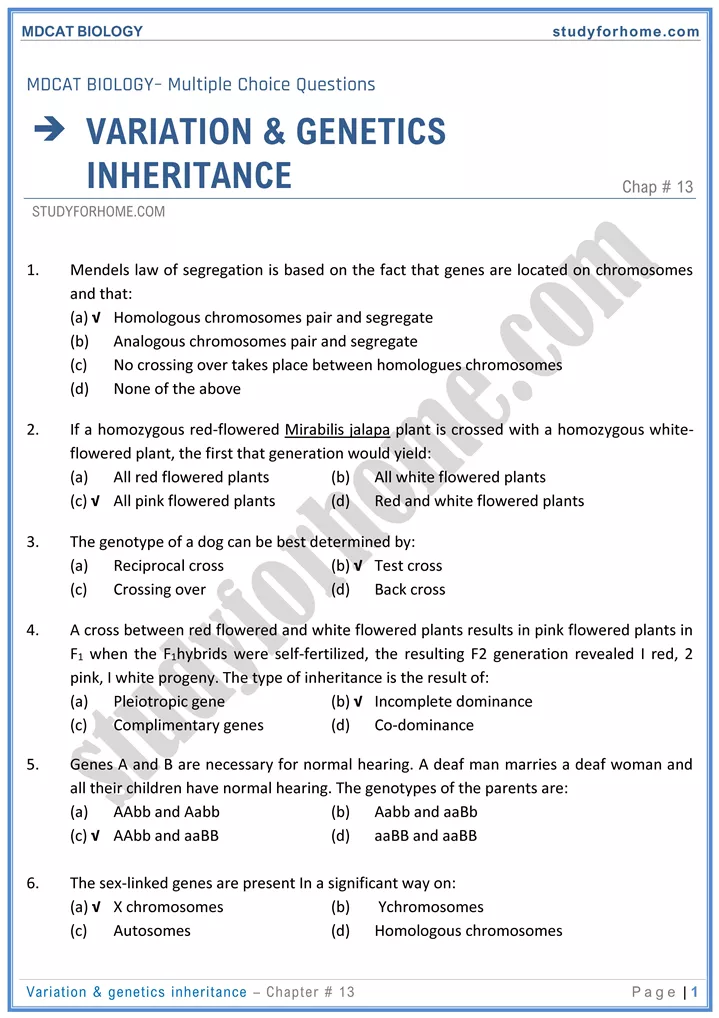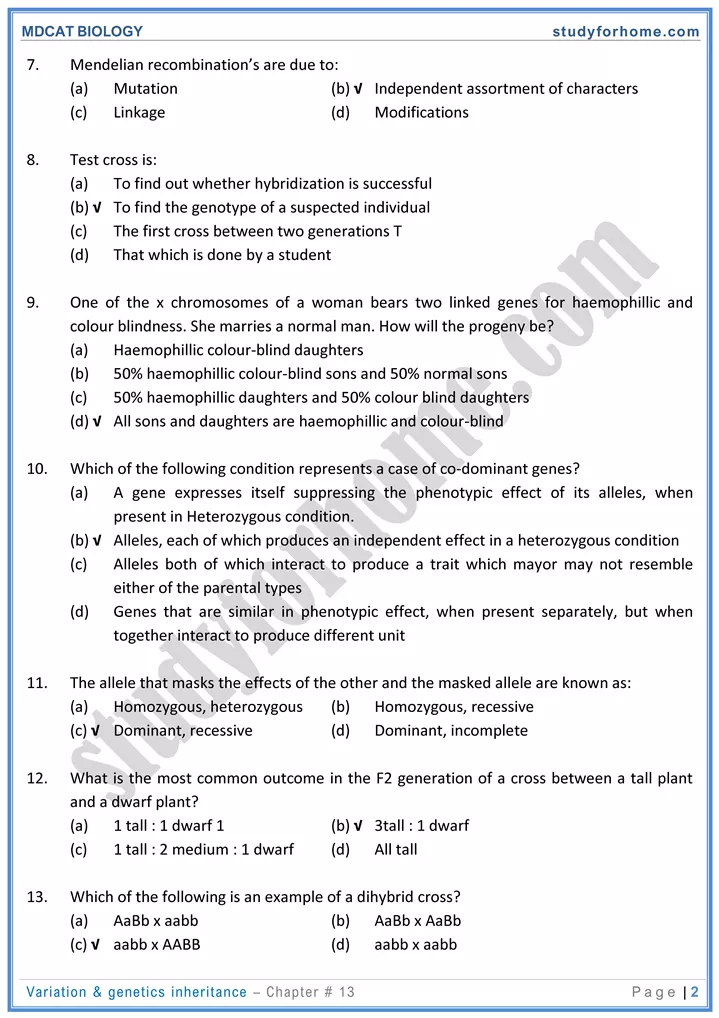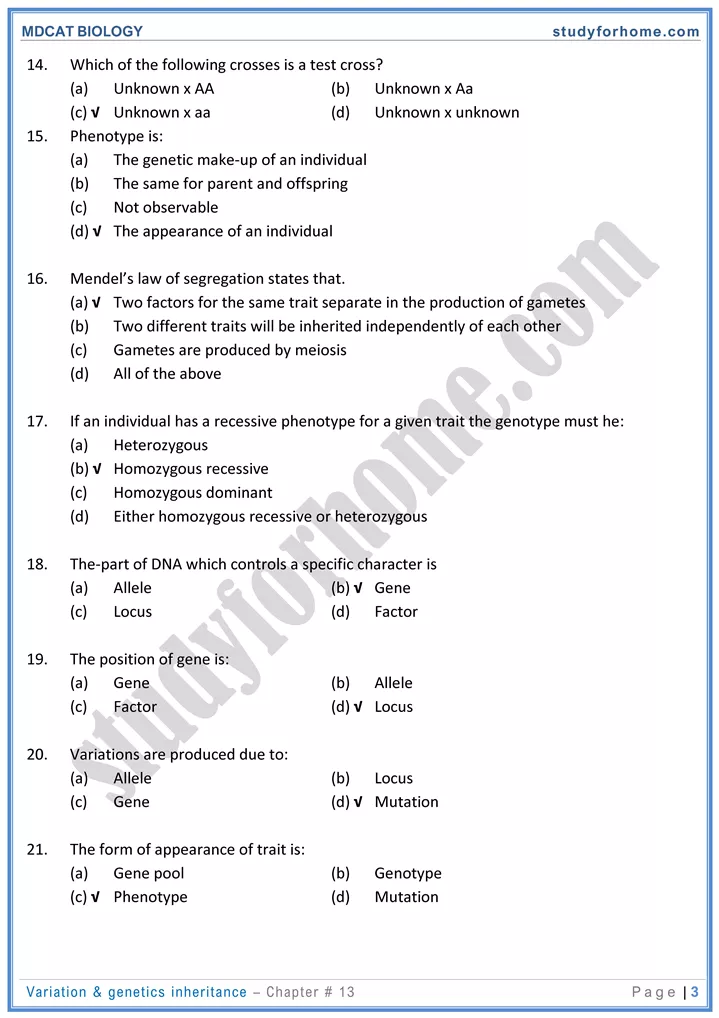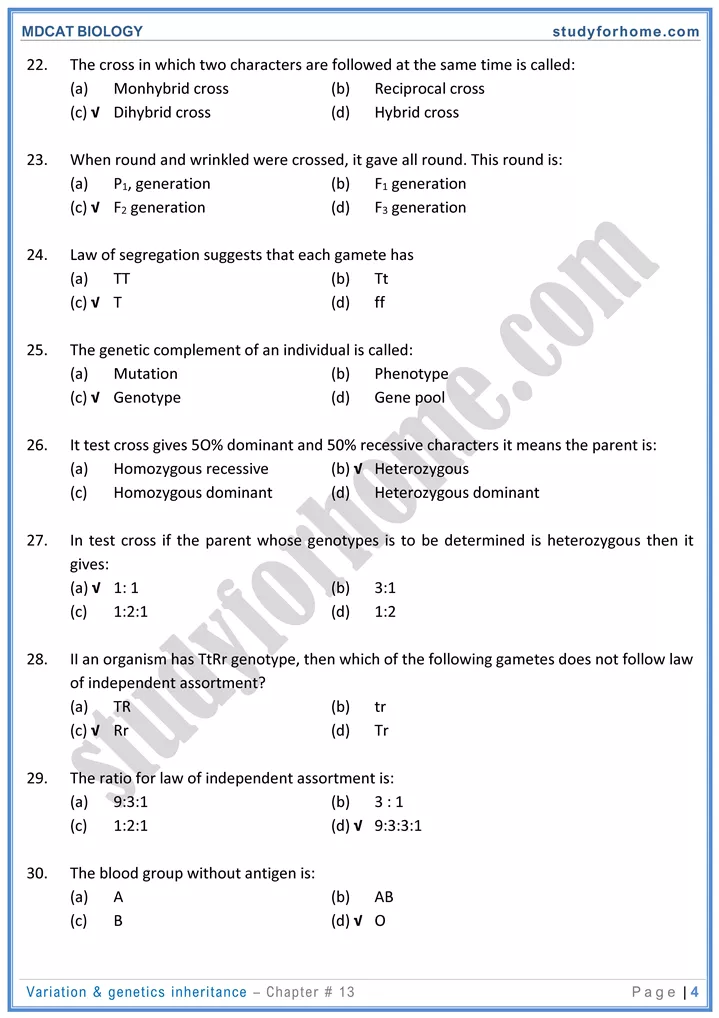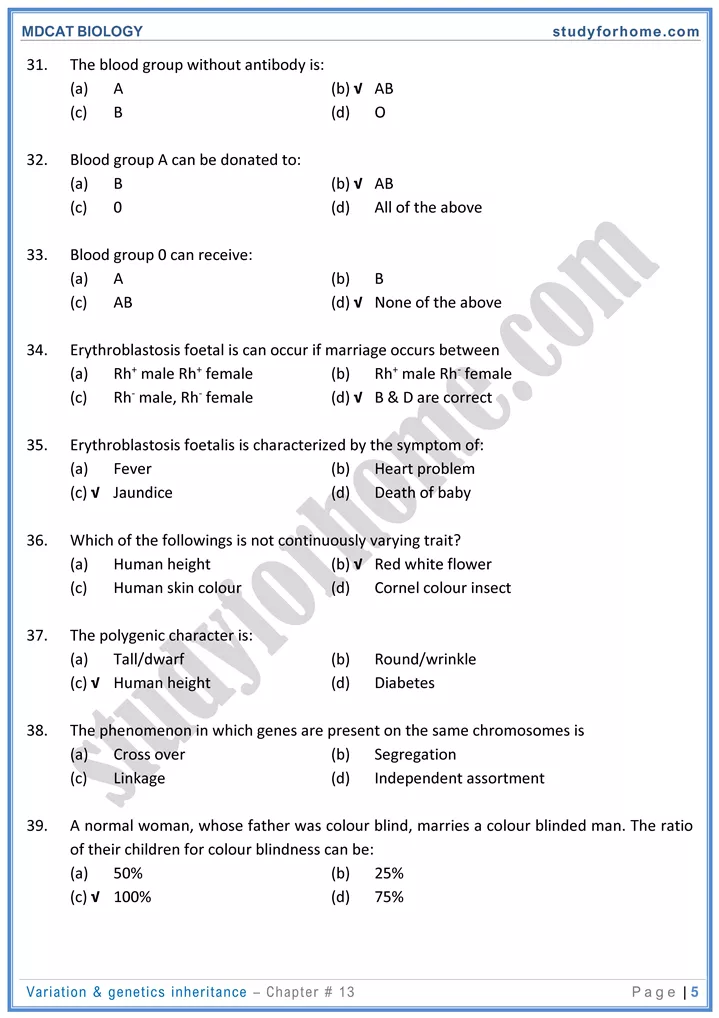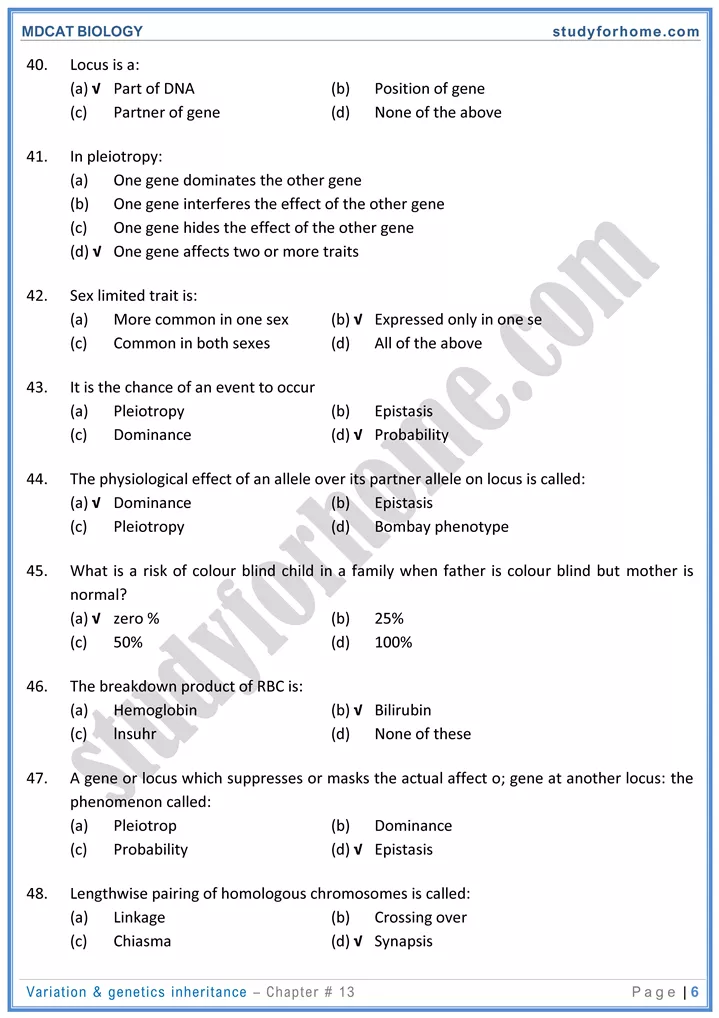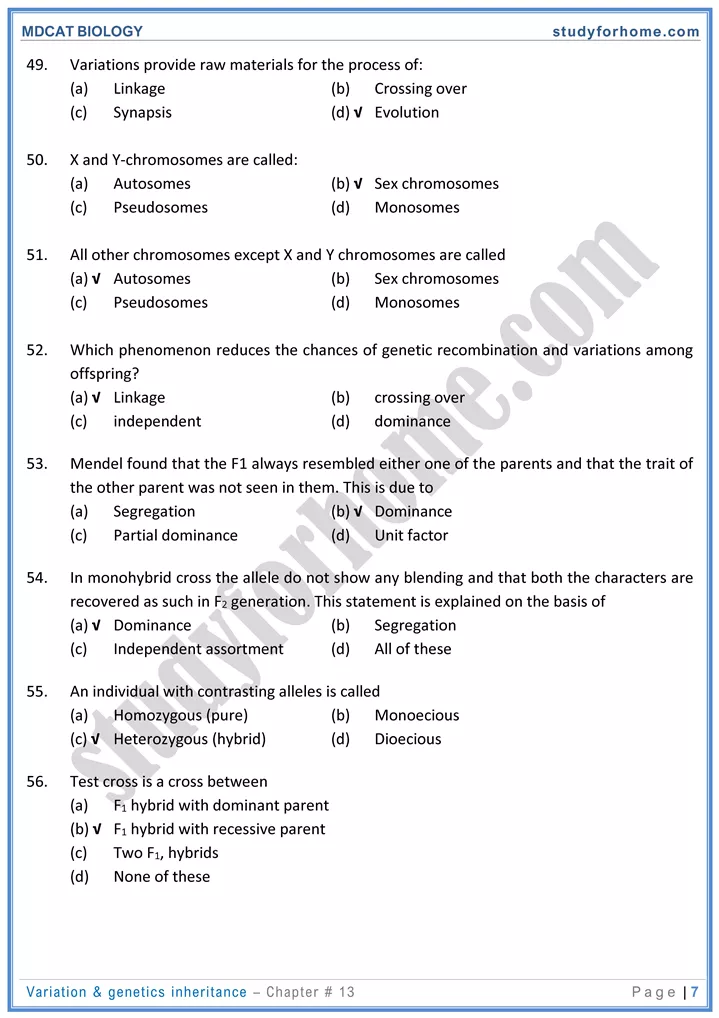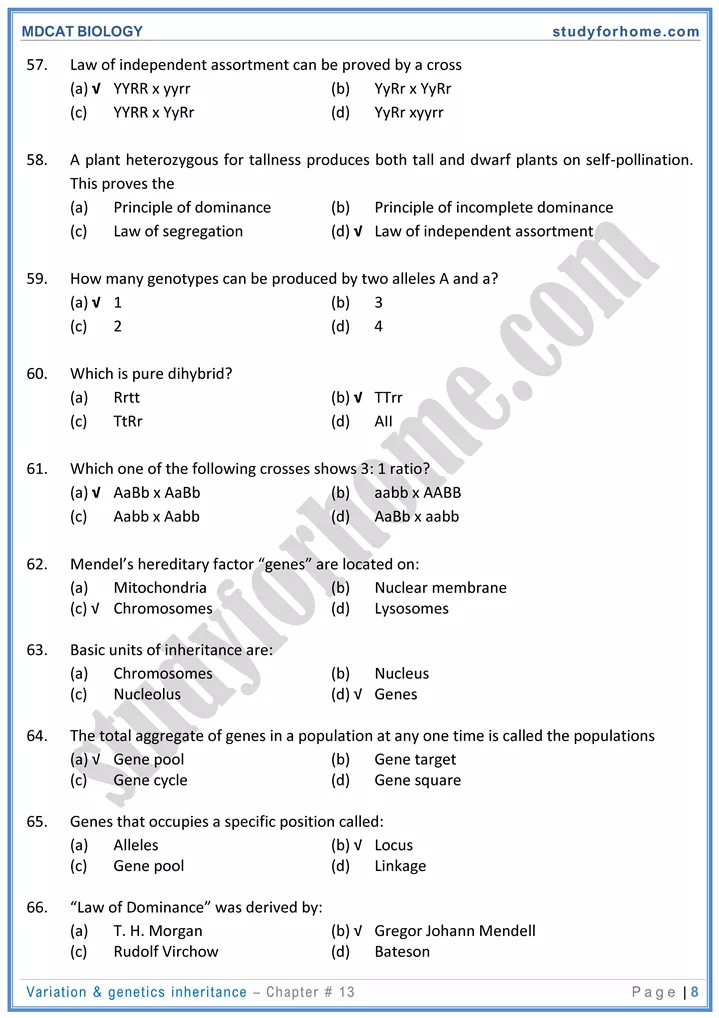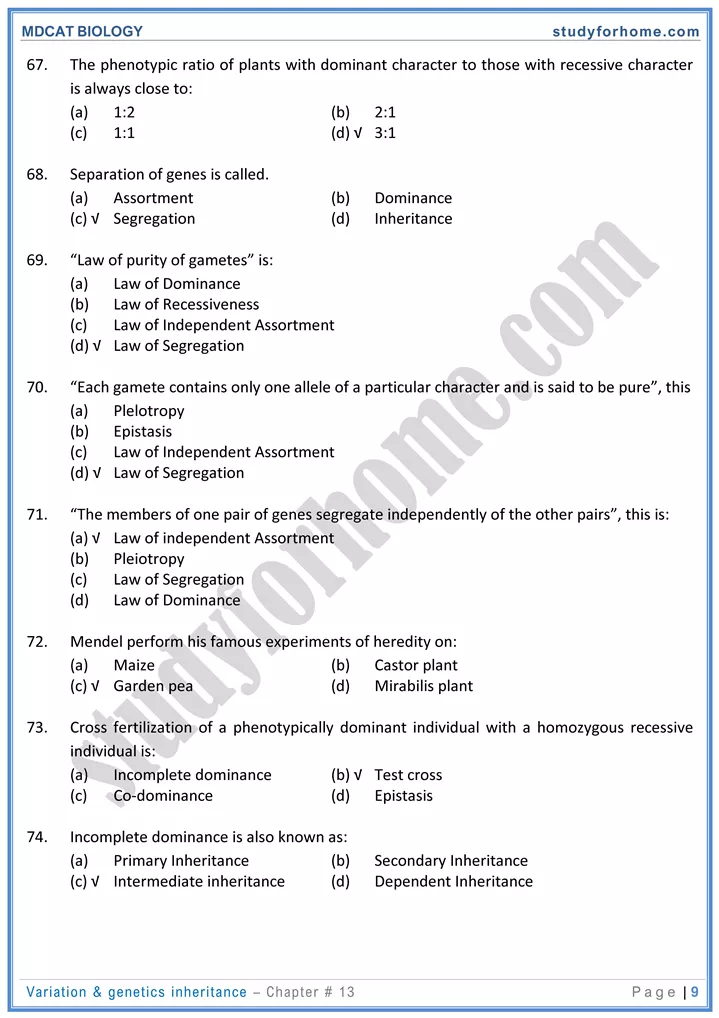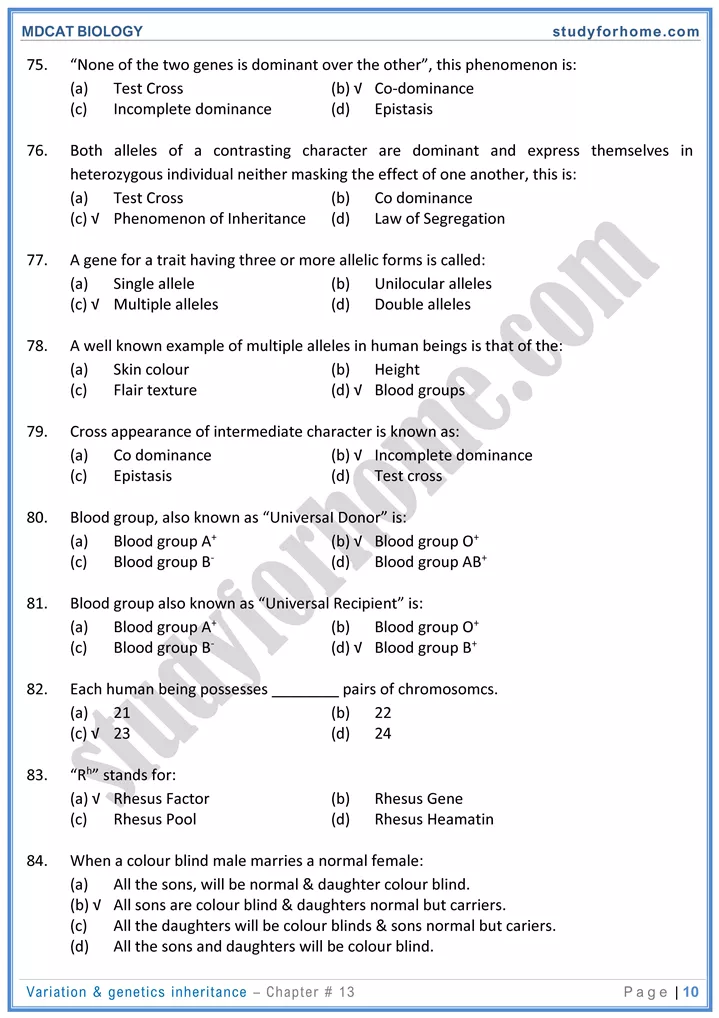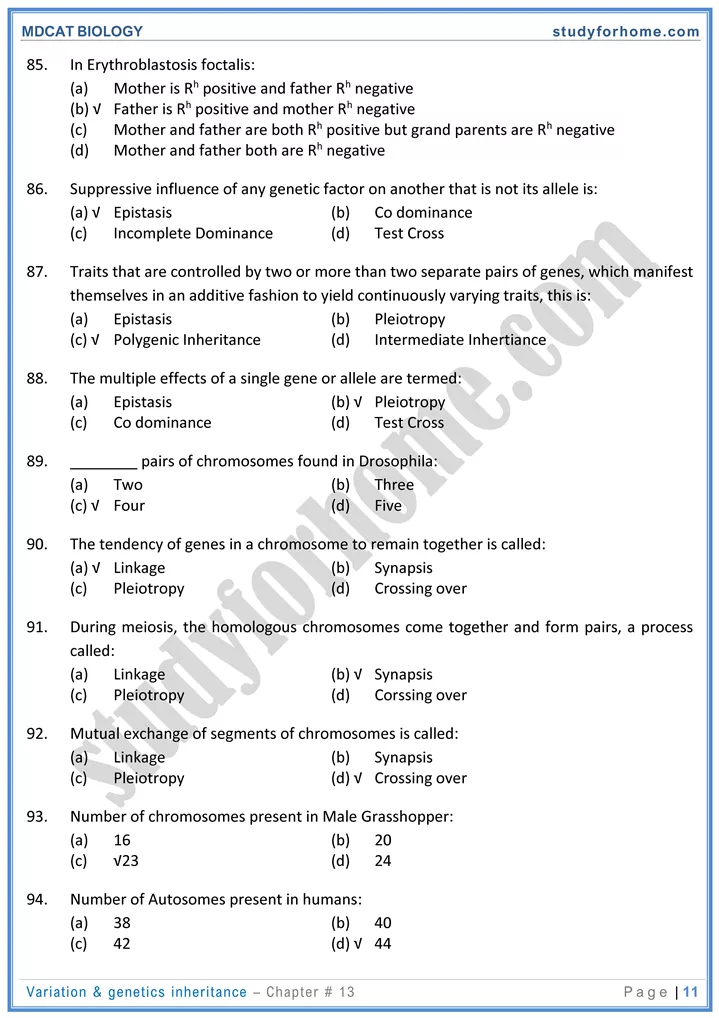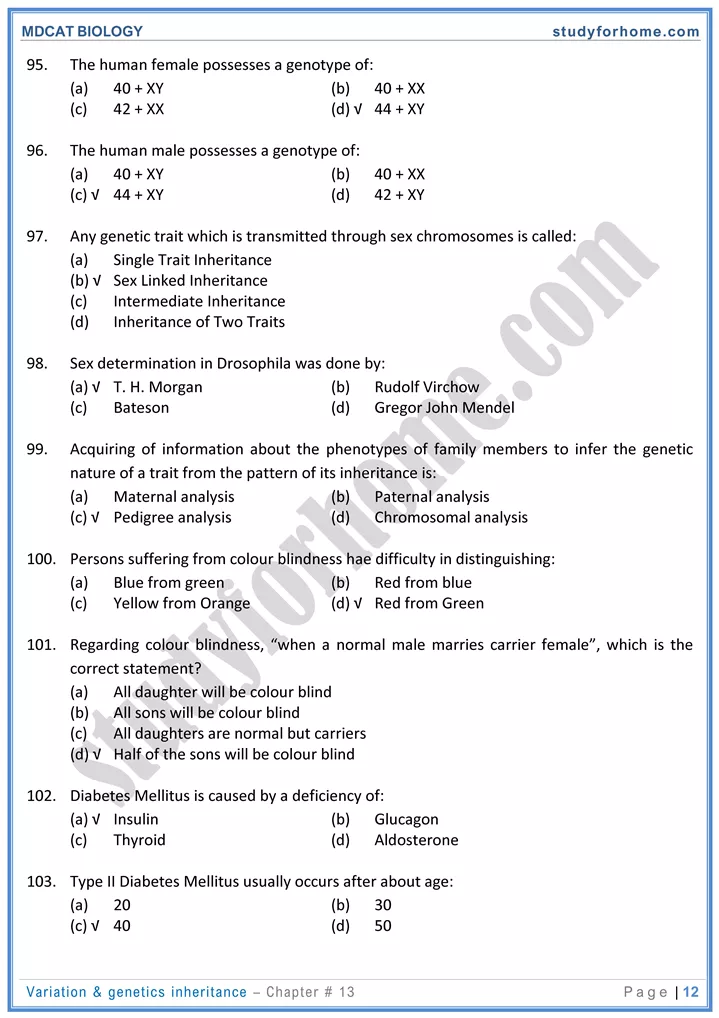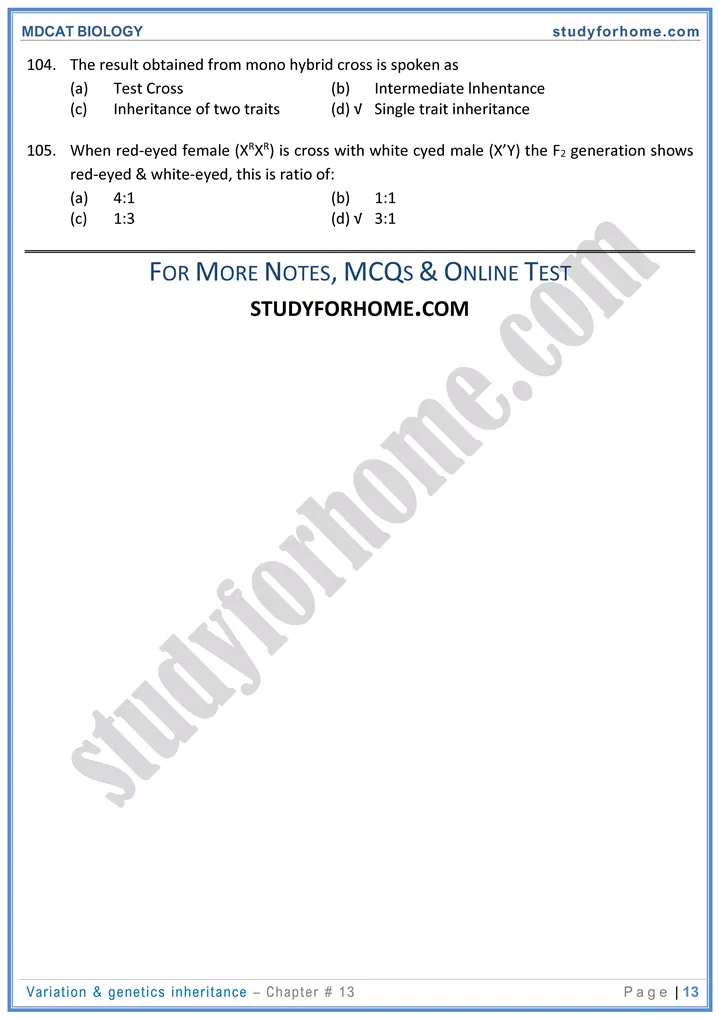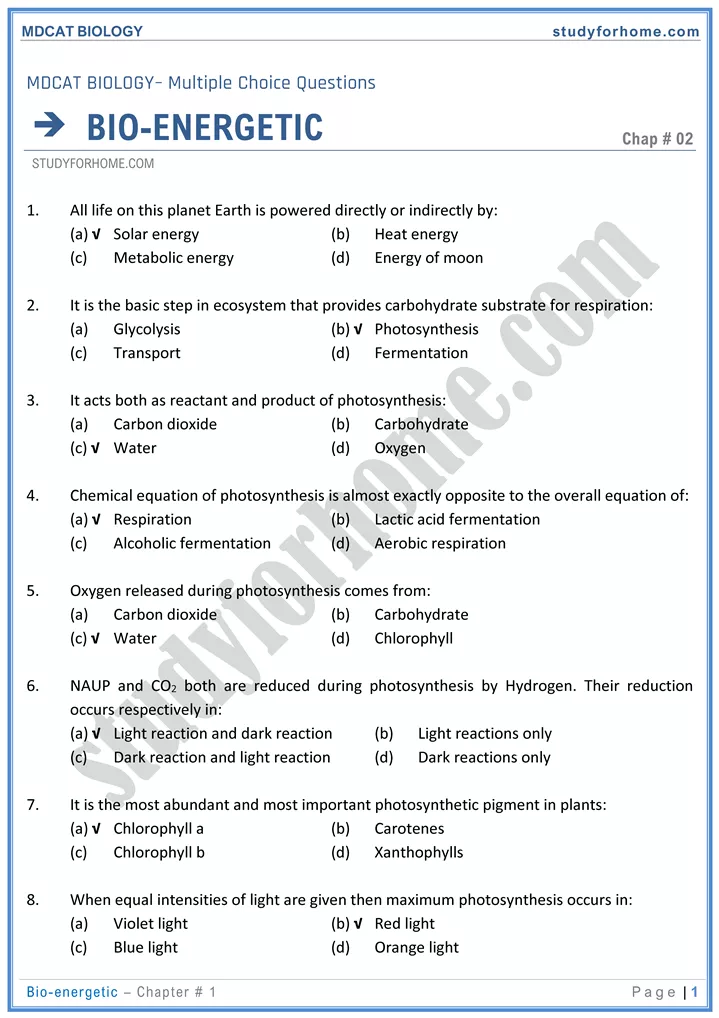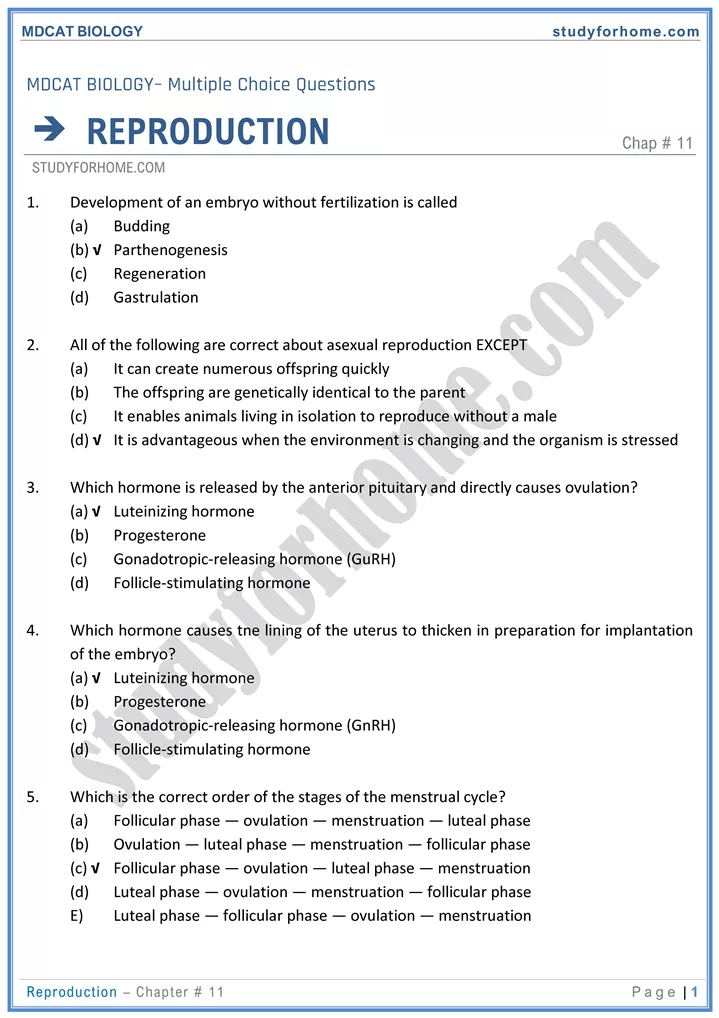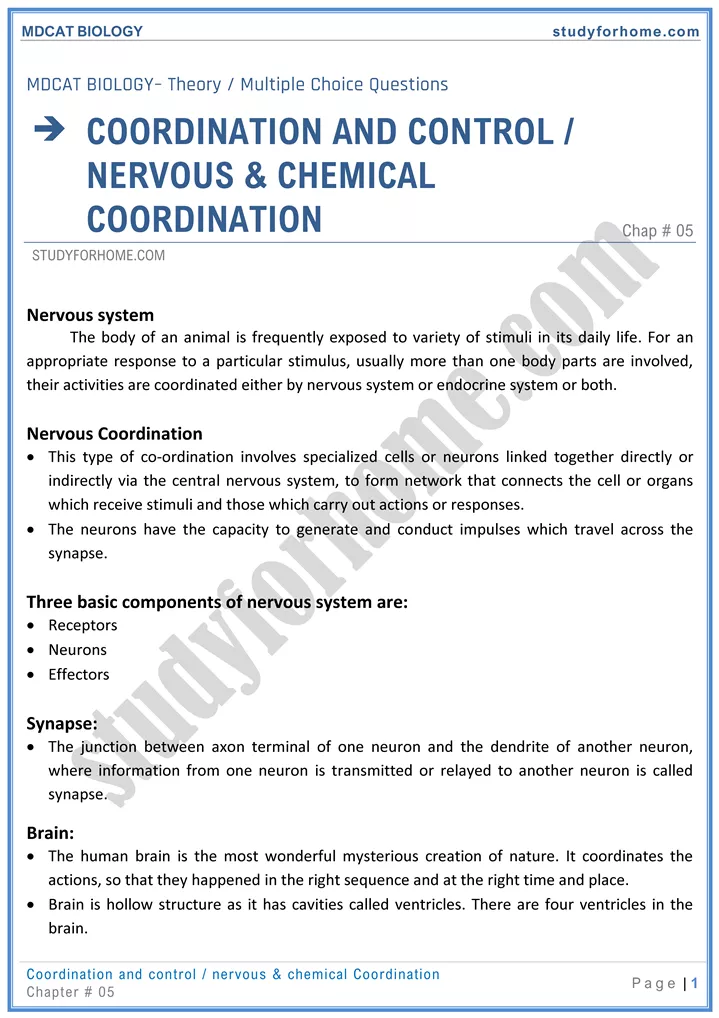Variation & genetics / inheritance – Chap 13 – Biology MDCAT
-
Gene:
- It is the basic unit of biological information. In fact, the DNA stores all sort of biological information coded in the sequence of its bases in a linear order, and genes are actually parts of DNA comprising its base sequences.
- Gene can also be defined as ‘the sequence of nucleotides that specifies sequence of amino acids in a polypeptide chain/protein molecule’.
- Hereditary characteristics pass from parents to offspring through genes in their gametes.
- When genes pass in the form of intact parental combination between generations, inherited similarities are conserved; but when these shuffle, mutate or juggle with each other, variations emerge.
-
Locus:
- The position of a gene on the chromosome is called its locus.
-
Allele:
- Genes form pairs on pairs of homologous chromosomes. One member of a gene pair is located on one homologue and the other member on the other homologue.
- Partners of a gene pair are called alleles.
- Each allele of a gene pair occupies the same gene locus on its respective homologue.
- Both alleles on one locus may be identical or different from each other.
-
Dominant Allele:
- Such an allele that masks the effect of other allele in a pair is called dominant allele and such trait is called dominant trait.
- For example, in pea plant, round (R) is dominant over wrinkled (r).
-
Recessive Allele:
- Such an allele that is masked by another allele in a gene pair is called recessive allele and such trait is called recessive trait.
- For example, in pea plant, green (y) is recessive while yellow (Y) is dominant.
-
Gene Pool:
- All the genes/alleles found in a breeding population at a given time are collectively called the gene pool.
- It consists of all the alleles at all genes loci in all individuals of the population.
- For a diploid species, each locus is represented twice in a genome of the individual who may be either homozygous or heterozygous.
-
Phenotype:
- Physical appearance of a trait is called phenotype.
- For example, round and wrinkled are phenotypes of seed shape as the shape is a trait.
-
Genotype:
- Genotype is the genetic complement i.e. the genes in an individual for a particular trait.
- For example, genotype of AB blood group is IAIB.
-
Homozygous:
- When both alleles of a gene pair in an organism are same, the organism is homozygous for that gene pair.
- An individual with homozygous genotype is called homozygote or true breeding.
- For example, RR is genotype of homozygous round seeded pea plant.
-
Heterozygous:
- If both alleles of a gene pair are different from each other, the organism is heterozygous for that gene pair.
- An individual with heterozygous genotype is called heterozygote or hybrid.
- For example, Rr is genotype of heterozygous round seeded pea plant.
-
Mendelian Inheritance:
- In 1860s Mendel discovered mechanism of inheritance based on his experimental work with pea plants. The first step of his experimental work was to develop true or pure breed varieties.
- A plant that produces all the off springs of its own phenotype upon self-fertilization is called true/pure breeding plants. These plants can be developed by repeated self-fertilization through successive generations until pure breed is achieved.
- Mendel studied seven pairs of contrasting traits for each contrasting phenotype; he developed a pure breeding plant.
- In second step, he performed hybridization, a cross fertilization between two individuals having contrasting phenotypes.
-
Selection of Pea Plant:
- Mendel performed series of breeding experiments on garden pea (Pisum sativum) in his monastery garden for eleven years. He selected pea plant for experiments due to following reasons:
- Pea plants were easy to cultivate.
- Its flowers were hermaphrodite. It was normally self-fertilized but could be cross-fertilized.
- It has short generation time.
- It has many sharply distinct traits and each trait had two clear cut alternative forms or varieties.
-
Law of Segregation inheritance of Single Trait:
-
Statement
- The two co-existing alleles for each trait in an individual segregate (separate) from each other at meiosis, so that each gamete receives only one of the two alleles. Alleles unite again at random fertilization of gametes when zygote is formed’.
-
Monohybrid Cross:
- Mendel studied inheritance of single trait in monohybrid cross in which two plants are crossed that differ on single trait.
- For the study of single trait of inheritance, he crossed a pure breeding yellow seed colored plants with a pure breeding green seed colored plants. He observed that generation was comprised entirely of individuals exhibiting only one parental phenotype i.e., yellow seed colored.
- When F1 generation was interbred/self-fertilized, its off springs/F2 generation showed a 3:1 ratio for yellow and green seed colors.
- Mendel got similar results and the same 3:1 ratio in offspring of monohybrid crosses for all the seven contrasting pairs of traits.
- Mendel proceeded a step ahead. He self-fertilized F2 plants to get the F3 He observed that 1/3 of F2 round produced only round (appeared true of pure breeding like P1 round), while 2/3 of F2 round produced both round and wrinkled in 3:1 (appeared non-pure breeding like F1 round); but F2 wrinkled produced only wrinkled (pure breeding).
-
Interpretations of Results:
- Based upon these observations, Mendel concluded that each contrasting form (phenotype) of a trait, e.g., yellow or green colors of seed was determined by particulate hereditary factors, which he called “elementens” (now called genes).
- These factors carrying hereditary information were transmitted from parents to offspring through gametes.
- Each pea plant had a pair of these factors (now called alleles, the alternative form of gene on the same locus).
- One derived from the male parent and other from the female parent.
- Yellow is dominant over green.
-
Limitations of Law of Independent Assortment:
- Genes are located on chromosomes at specific loci. Independent assortment of genes depends upon independent assortment of their chromosomes.
- All the genes present on a homologous pair of chromosomes are linked to each other in the form of a linkage group. These cannot assort independently.
- Those alleles assort independently whose alleles are riding non-homologous chromosomes.
-
Usefulness of Law of Independent Assortment:
- Mendel’s law of independent assortment explains that if two parents have unique set of traits which are desired to express in one individual, so it is possible only because of independent assortment.
- Furthermore, if two parents have such traits which they do not want to be expressed in their offspring. This is also possible only because of independent assortment.
-
Scope of Independent Assortment in Variation:
- Beside mutation and crossing over (which are sources of variation), independent assortment of traits is also a major source of variations in successive generations.
- It is only due to the crossing over and independent assortment of the traits that the characteristics may appear in new combination in next generation which often seems necessary for adaptations in varying environment.
-
Probability and Product Rule:
- Probability is the chance of an event to occur e.g. in F2 offspring of a monohybrid cross the independent chance for a seed to be round is 3/4 and wrinkled 1/4.
- When two independent events are occurring simultaneously like in dihybrid cross, the ratio of each joint phenotypic combination can be obtained by multiplying the probabilities of individual phenotypes. It is called product rule.
-
Dominance Relations:
- Dominance is a physiological effect of an allele over its partner allele on the same gene locus.
- The relationships between the contrasting alleles at the same locus in heterozygous state are called dominance relations.
- Although Mendel had observed mainly only complete dominance, but later on many geneticists became able to explain several exceptions to the Mendelian inheritance that could not be explained on the basis of complete dominance.
- These exceptions are said to be non-Mendelian inheritance patterns and include incomplete/partial dominance, co-dominance and over dominance, each indicating a different style of their functional effect upon each other.
